Note: In our second installment of the Space City Rewind, we tackle the biggest snow on record in Southeast Texas. Our first installment about the November 1992 tornado outbreak can be found here.
“All of Wednesday night polar spirits swept the earth until boundless snow had deformed the withered heath and the people of this section for the first time within the memory of the oldest inhabitant, looked out upon nature fringed with a beard made white with other snows than those of age.” – Brenham Daily Banner, February 15, 1895
Back on Christmas Eve in 2004, much of South Texas was blanketed in white, as a perfect setup to create a miraculous White Christmas occurred. Galveston received four inches of snow, Angleton six inches, Friendswood three inches, and Bay City 8-10 inches. While the 2004 Christmas Eve miracle stands almost on its own for modern Southeast Texas snowstorms, the great Valentine’s Day snow of 1895 stands alone as Southeast Texas’s and the Gulf Coast’s greatest snowstorm of all-time. The following interactive map shows snow totals from this remarkable event, which affected a swath from Texas to Maryland.
Above: An interactive map with snow reports and some details from the 1895 storm
So why did this event occur? How disruptive was it for coastal residents? Will we ever see its like again? Put your feet up, because the latest installment of the Space City Rewind takes you back to the 19th Century: The Great Snowstorm of Valentine’s Day 1895.
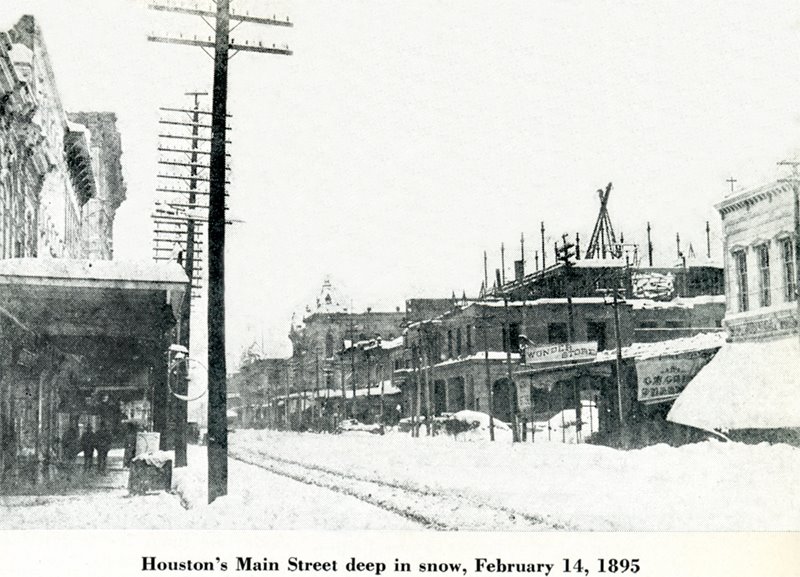
The Meteorology
How does a massive snowstorm develop in the Gulf of Mexico? We have scant data to look at from 1895. Thus, we have to rely primarily on newspaper accounts of the storm and our knowledge from modern storms, such as Christmas Eve 2004.
Let’s start with how we got here first.
The winter of 1894-95 was, in a word, cold. In my research of this event, I came across news stories and even letters from the Plains pleading for help due to that winter’s extreme cold. This particular dispatch in the February 17, 1895 Galveston Daily News described the suffering experienced in Oklahoma:
“Many settlers are killing prairie dogs and eating them, having nothing to feed their families. They are in a piteous state of destitution without parallel in the settlement of new countries. It may be painful to drag before the public the distressing picture of a single individual starving to death, but when multiplied many hundred times one can then form a picture of this accumulated suffering.”
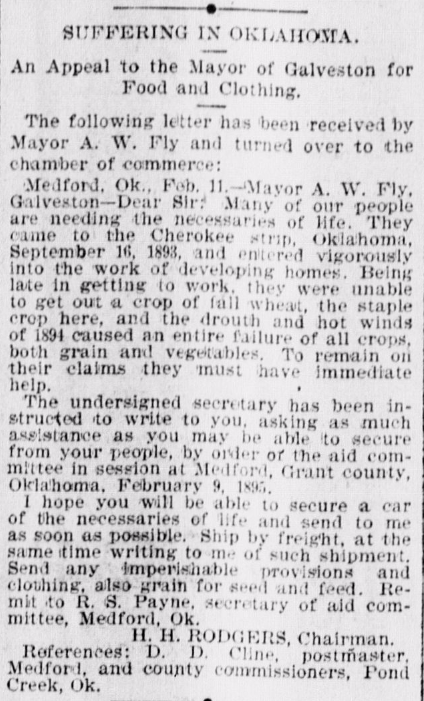
The citrus crop in Florida was absolutely decimated in the winter of 1894-95, in some cases permanently. Two serious freezes did back to back damage on most of that state’s crops.
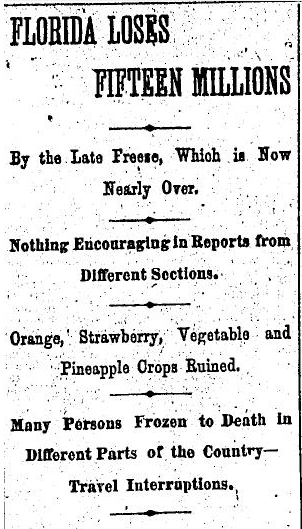
Meanwhile, for Houston the winter of 1894-95 ranks as the eighth coldest on record (weather records in 1895 came from the downtown weather bureau office). Six of Houston’s 35 coldest days on record occurred in the 1894-95 winter, and by nearly two full degrees, February 1895 remains the coldest February in Houston’s weather records. It also just trails January 1978 for coldest of any month on record.
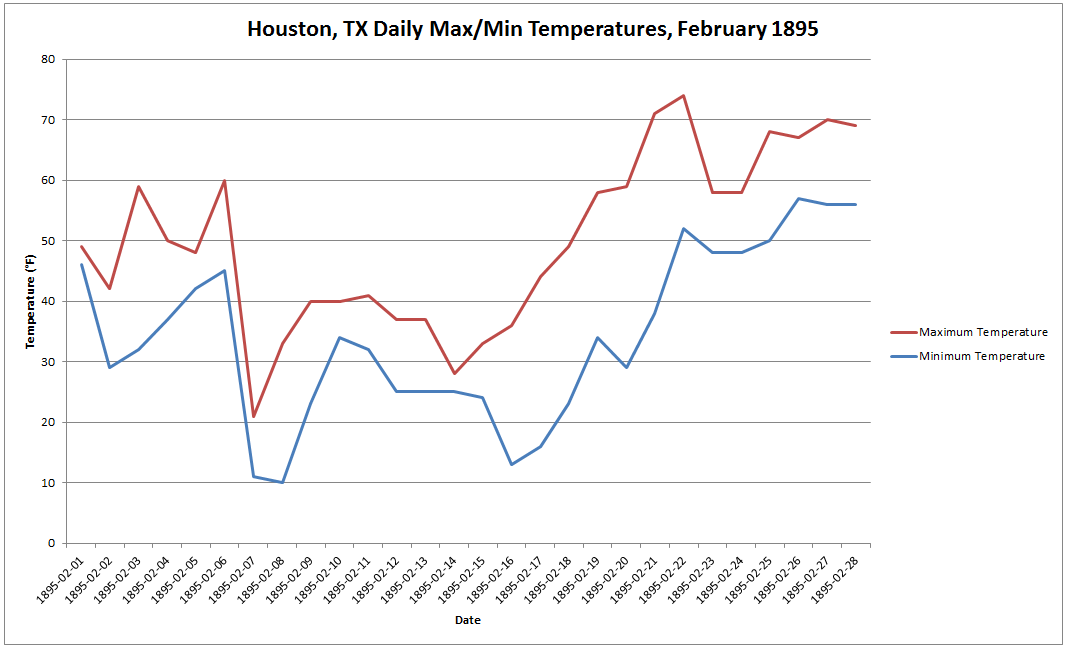
Despite being the second coldest month on record, February 1895 was a bit of a roller coaster to start. Temperatures peaked on February 6th around 60° before a mega-cold front blasted in on February 7th, when the day’s high temperatures didn’t get out of the low 20s. You read that correctly. The only other day as cold as February 7, 1895 occurred on February 13, 1899 (known as the Great Arctic Outbreak), when Houston hit just 20 degrees. After a low of 10° on February 8th (the fifth coldest morning on record in Houston), we warmed back up into the 40s through the 11th. Another reinforcing cold front seems to have swept across Texas on Tuesday the 12th and Wednesday the 13th. It likely arrived in Houston on Wednesday evening, as the Houston Post recounted in their Thursday morning edition:
“The unusual sight of falling snow was witnessed last night in this city. The wind was blowing steadily from the north and a cold, misty rain which began to fall between 7 and 8 o’clock, soon changed to sleet and then to snow. At midnight, the streets were covered with an exceedingly thin mantle of snow, but the indications were that the fall of snow would probably be changed to rain. It has been five or six years since any snow fell in this city, and it will be quite a novelty to many should it remain on the ground until this morning.”
Daily weather maps, published in 1895 by the US Department of Agriculture are really the only raw observed data we can study. Based on the maps, the simplest explanation of the evolution of the 1895 storm was this: A front moved through East Texas on February 13th and reinforced the cold air overhead. Cold air continued to filter in from the north (as seen by north winds cutting straight down the Plains deep into Texas on the morning of February 14th).
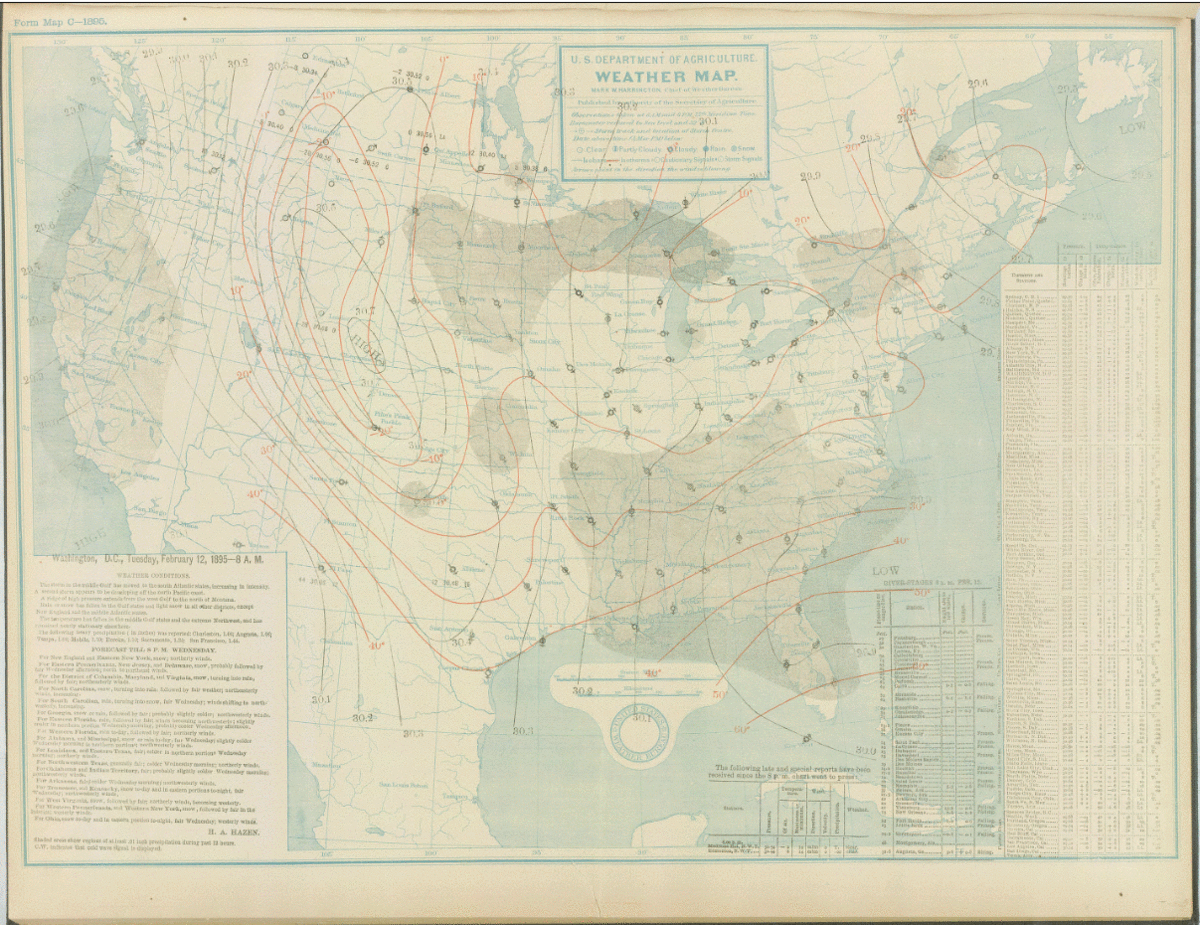
Meanwhile, you can see on the daily weather maps above that precipitation in California on the morning of February 13th moved into the interior Southwest and Texas by February 14th. My hunch is that an upper level disturbance was passing through, which set up a pretty significant overrunning event in Texas and Louisiana. Overrunning is where warm, moist air aloft flows over dense, cold air at the ground. As this happens, it can lead to precipitation, which, during a typical East Texas winter, usually falls as rain. But, obviously if temperatures are cold enough and the atmospheric conditions are just right, precipitation can fall as sleet, freezing rain, or snow. This is what occurred in the 2004 storm.
Based on the surface maps above, what may have set February 1895 apart was probably an additional surface low pressure that developed in the Gulf Wednesday night and Thursday and swept west to east offshore from Texas to Florida. Many of the accounts I read in Louisiana noted that snow stopped or tapered off before really ramping up on Valentine’s Day afternoon and evening. This is consistent with a storm passing by offshore (and strengthening, as wind was mentioned a bit more prominently in Galveston and Louisiana newspapers than in Houston or interior Texas ones). The storm cut across Florida, dropping snow as far south and east as Tallahassee and Lake City. It’s tough to presume what happened after this point. My hunch is that a secondary low developed a bit further north than the first one, traveled northeast, and dumped a healthy snow in the mountains of the Southeast, into Virginia and as far north as Delaware before exiting. Either way, what occurred in mid-February 1895 was truly a meteorological anomaly, possibly one of the greatest weather anomalies in U.S. history, and one of the most interesting storms I’ve ever researched.
(Post continues on next page)
BRAVO!!! What a great, well researched piece and all the stories within the story…loved the old pictures…sure wish we still had some of those beautiful old buildings…a number of chuckles, especially reading about state legislators in Austin dodging snowballs trying to exit the capitol…guess citizens back then shared differences with politicians…imagine that!
Thanks, Milt! Stories like this definitely make you appreciate the good parts of the past. I just can’t imagine seeing how beautiful Houston must have looked on Valentine’s Day morning that year.
Thanks for sharing!
Awesome stuff. Loved every bit!
Thanks, Brad!
Very interesting! Would love to experience snow again someday.
Agreed. Doubt we’ll see a storm of this magnitude/scale again, but we’ll probably see snow again one day.
Thank you, Matt! This was a treat to read. Wish something like this would happen again for us …
Thanks, Katie! It would be pretty incredible to see it happen again for sure!
What a fabulous and fascinating presentation! Thank you so much for all your work in doing this!
Thanks, Susan!
History can be so fascinating. And snow is so magical to us native Houstonians.
I loved the way this was put together, Matt. I always look forward to these forays in the past. Thanks so much for your effort.
What a fun read and the research needed to put this together must have taken weeks. The other take away is the prose contained in the newspaper reports. Just amazing.
fantastic article. Must have been strong upper feature following on front. dwarfs the 4 inches I say in College Station Jan 1964.
Thank you, Joe. Yes, I think a front followed by some wild upper level system digging out of the Southwest set off a fuse in the Gulf. Would be absolutely incredible to witness today.
Cool!
Oh my Goodness….Milt…..THANK YOU so very much for researching and writing this article …..please pass your information to the State of Texas historical society for I am sure the information will be read for generations to come. As a lifelong resident of Oklahoma I found the letter from Medford OK pleading for help from the people of Galveston particularly interesting. The letter shows multiple points about the histories of both Oklahoma and Texas. It proves, once again, that there were many people already homesteading in Oklahoma….waaaay before the 1901 Land Lottery. Once again, we earn the name Sooners . . . it also serves to remind US ALL….the citizens of Texas and Oklahoma……that no matter the scores in various competitions between Oklahoma / Texas (Texas / Oklahoma…..for Texans reading this)…..no matter the heated competitions……that our two states have a long history of coming to aid each each other through thick and thin……….WE help each other. My heart broke for Houston after Hurricane Harvey. I was also terrified having a nephew and his young beautiful sweet family living in Houston and water coming closer to his home every minute. I know the Houston recovery is continuing to this day. Houston has always been a shining city and will come out of Hurricane Harvey full of hope, light and goodness…..an example to the world of Hope and fulfillment of Hope…..a sparkling prosperous and affluent society.
Well said, and no worries about the name!
Matt…..I so apologize….I recently posted about this story and realized I called you Milt….I am sorry for that….truly….
Absolutely wonderful account, Matt. As a Houstonian with relatives in OK, I was reminded by Victoria’s post of why Texas is often referred to as Baja Oklahoma.
Does anyone know — was this the same storm that led to the name “Frozen Point” on East Galveston Bay where free ranging cattle were pushed to the bay for warmth and perished there?
You would be correct! https://www.crystalbeachlocalnews.com/frozen-point-and-the-snow-of-1895/